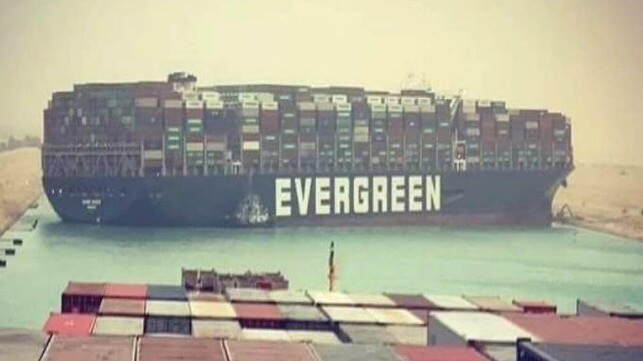Panama Issues Report Critical of SCA Pilots in Ever Given Grounding

More than two years after the grounding of the Ever Given containership in the Suez Canal, the Panama Maritime Authority’s Marine Safety Investigation Report has been filed with the International Maritime Organization and become public. As the flag state for the vessel, Panama’s investigative team had access not only to the crew but also to the bridge data recorders and was able to give the most comprehensive analysis of the events.
Panama’s report is critical of the Suez Canal pilots and their performance during the transit and their actions leading up to the grounding. They highlight multiple issues ranging from communication to their management of the vessel. They also cite elements from the crew’s actions while highlighting that the vessel and its navigation equipment were all in good order and were not an issue in the event.
On the night before the transit, data shows the vessel had experienced high winds in the anchorage and at one point the Ever Given along with at least one neighboring container ship were both dragging anchor. Due to the high winds, the captain had repositioned the Ever Given.
The first pilot came aboard at 5:48 am on March 23, 2021, with the role of starting the convoy and getting the containership into the Suez Canal. Data shows there was discussion over the correct position of the Ever Given in the convoy. Panama concludes that the first pilot had not been updated by the authorities on the positions in the convoy but the transit got underway without incident. The first pilot was aboard for about one hour and 40 minutes before handing over to two other pilots for the transit.
At around the time of the handover, around 7:20 a.m., winds had increased dramatically with gusts up to 40 mph, and blowing sand was greatly reducing visibility. The master and pilots were having difficulty maintaining the Ever Given’s position in the center of the channel and the pilot ordered an increase in speed to 12 knots. The Suez Canal’s designated maximum speed is 8.64 knots, but Panama notes excessive speed however is not uncommon while transiting the Suez Canal.
One of the pilots was officially giving the orders while the other was advising and monitoring the transit. Under Suez Canal rules, the pilots are advising the vessel while the master remains in official command. Panama notes that on at least two occasions the master of the Ever Given intervened, changing the pilot’s orders for rudder position. Panama notes the pilot was ordering the rudder from hard to port to hard to starboard, never to midships and not giving the helmsman a course to steer to.
Panama reports from analyzing the voice data recording that the pilots were conversing in Arabic, although the 25-member Indian crew, including the master, did not speak Arabic. They translated the Arabic from the recording and found that the pilots were arguing, and by 7:37 a.m. “It appears the pilots started to realize that they could not control the vessel and that there was a risk of grounding.”
The pilot who was monitoring the transit was calling for slowing the vessel and giving the helmsman specific course directions instead of rudder commands. By 7:38 a.m. the Ever Given is moving first to port and then starboard while the pilots first reduce speed and then increase speed. The vessel appears to be moving from one side of the channel to the other and back again. Three minutes later the vessel is aground with the master intervening attempting to get the ship free.
Panama identifies a list of factors contributing to the grounding. While a voyage plan had been prepared and reviewed, they said the pilots did not take into consideration weather conditions and did not request assistance from tugs. The speed was in excess and the commands were only hard over orders for the rudder.
From the beginning of the transit, the Ever Given was deviating from the planned course creating a “swing effect” in the navigation. Further, the pilots failed to consider the effect of squat, bank suction, and bank cushion on the navigation. The pilots were not verifying the ship’s position to the planned course and not consulting with the master who had a better knowledge of the Ever Given and its navigation.
“Language difficulties can also add to the problems associated with the pilots and these should be considered,” the investigation found. “In the case of the Ever Given, although the pilot’s orders were given in English, the discussion between them was always in Arabic, therefore the bridge team could not understand the pilots’ concerns (if any), the potential hazards,…” the report concludes.
The report provides a long list of recommendations both for vessel operators and the Suez Canal. For vessels making the transit, they recommend crew training, ensuring clear communication with the pilot, evaluating the pilot’s actions, and monitoring the vessel’s progress.
Key among the recommendations to the Suez Canal Authority is that all navigation communications should be in English because Arabic discussions about navigation can not be understood by the master or crew. They also recommend that as ships are getting larger, the pilots should be getting additional training for the navigation of large vessels and the impact of weather. They are also recommending refresher courses for Suez Canal pilots with respect to squat, bank suction, and bank cushion effects on different types of ships that transit in the Suez Canal, as well as on canal characteristics (winds, currents, depth. etc.).
While they find that the master and crew’s interventions were ineffective in preventing the grounding, the Panama Maritime Authority’s report cites multiple issues with the pilots that they believe need to be addressed. They also call on the Suez Canal Authority for better preparation, warnings, and salvage capabilities to prevent similar grounding that blocks the canal for an extended period of time.
